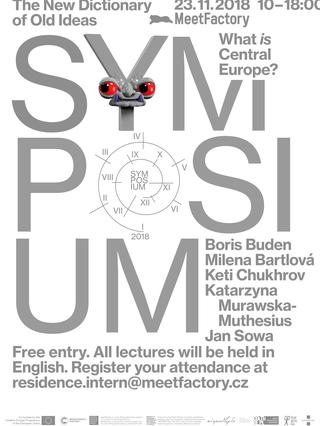 How to get to us
How to get to us
MeetFactory, o. p. s.
Ke Sklárně 3213/15
150 00 Praha 5
GPS:
50.053653
14.408441
Opening hours:
13:00 do 20:00 + based on evening program
The New Dictionary of Old Ideas
Partner Institutions:
- HIT Gallery / Bratislava, Slovakia
- Visual Culture Research Centre / Kyiv, Ukraine
- FKSE Studio of Young Artists Association / Budapest, Hungary
- Trafostacja Sztuki / Szczecin, Poland
- tranzit.at / Vienna, Austria
- ODD / Bucharest, Romania
Participants:
Andrej Žabkay, Kata Mach, Serhiy Klymko, Oleksiy Radynski, David Chichkan, Oleksander Pavlov, Klára Rudas, Bence Pálinkás, Miklós Zsámboki, Eszter Őze, Monika Szpener, Stanisław Ruksza, Andrzej Wasilewski, Mikołaj Iwański, Georg Schöllhammer, Hedwig Saxenhuber, Tanja Widman, Johannes Porsch, Nita Mocanu, Cristina Bogdan, Marius Stoica, Vasile Leac.
The New Dictionary of Old Ideas is a network of independent cultural institutions within Central and Eastern Europe. The platform we aim to create comes along with the process of cultural exchange and intense research of our common identity. Through political issues, visual culture, art theory, and the history of the region, we wish to explore Central Europe as an intriguing phenomenon. Coming from the experience of cultural mobility, we have established a residency project as a helping tool in furthering research that goes hand in hand with a set of theoretical terms known as The New Dictionary of Old Ideas.
Retroutopia vs. Speculative Fiction
The idea of a retro-utopia is used by Boris Buden (referring to Inke Arns) which suggests that similar to the myths of the pre-modern era that it once replaced, utopia is now focused on the past. However, that is not to preserve it but rather to remain faithful to its liberating promise. He does not imply that a better world was only possible in the past, but that the improvement of the world without the past is simply impossible. Retro-utopism is turning to the past merely in order to extrapolate its unrealised ideas into the future.
The Misery of Catching Up
The very terms “revolution,” “velvet revolution,” and “transformation” still remain debatable. At the same time, they do capture the variety of ways in which particular countries viewed their communist past, seeking their way outside the Iron Curtain.
The much-desired West “overwhelmed” the neglected East with the dominance of VHS cassettes, fake shoes, cheap sun-beds and businessmen in tattered socks. It was an exotic mix of the 1990s in which the post-communist greyness was tinted by the new democracies of acid green and purple.
Common Task!
The “West” and the “East” neither share a common past nor a present. It is indeed the future where both worlds will meet one another. This is a statement given by Rastko Močnik in his text EAST! Although the West and East clash in times of instability caused by political turmoil, the boundaries between them are growing around us. Common task refers to a better future that goes against these tendencies and instead of being a particular claim, it refers to experiments with the strategy of memory.
Political Practices and Culture
In the time of national revivals in Central Europe, art was used, but also wittingly created, by artists to support the national idea of helping individuals identify themselves through the culture with the forming nation. The second wave of the strategic use of culture to promote the national idea emerged along with the formation of the new nation states after World War I as a result of the Versailles Peace System. Later, the relationship with public/state institutions became questioned during totalitarianism. What kind of political practices can be traced in the region to the so called Central European region, and how do these practices affect culture, or more precisely, art practices?
Identity Paradox
Central Europe had different geographic as well as diverse geopolitical dimensions at different times. Geographically, it was indeed an “elastic region”. Based on the current political situation, it was once expanding, and at another time shrinking. None of the terms used to define this region are neutral. They are all influenced by political and historical connotations and include a diverse territory within Europe – Mitteleuropa, Central Europe, Central East Europe, etc. Is Central Europe a fact, a utopia, a concept of thought, or just a chimera? Debates about the character, the existence or the non-existence of Central Europe, have been emerging in the waves since the 1970s, and the issue is still not resolved or concluded in any satisfactory way. Perhaps this intangible ability of Central Europe is its most important characteristic.
Solidarity vs Unity
Our union is a higher form of individuality! Through this term, we are eager to investigate how a model of an union embodies needs for collectivity in the post-Soviet democracies and reflect on why it is still powerfully present in the Central-European context. Does it stem from a basic need for self-defence expressed in a phrase: “United we stand, divided we fall,” or is it nothing but propaganda slogan, a spectre that haunts totalitarian ideologies? What becomes a natural counterweight supplement to unity is solidarity – a term that gained a lot of attention because of the Polish opposition movement in 1980. However, unity gives us an ideal status in an idealistic social stratification – all equal – solidarity answers to the question: what if there are equal and more equal. Solidarity is a way how carrying country balances social diversities and processes social justice.
Schedule:
MeetFactory residences – February – November 2018
Project launching + VCRC and tranzit.at – 28th of March 2018
Open studios MeetFactory – 13th of April 2018
Public event + FKSE presentation – 15th of May 2018
Open studios MeetFactory – 9th of June 2018
Public event + Trafostacja Sztuki project presentation + ODD project presentation – 9th of August 2018
Open Studios MeetFactory – 21st of September 2018
Symposium – 23rd of November 2018
10:00-19:00
Free entry, You need to register your attendance at residence.intern@meetfactory.cz till 19 November.
More info here
Concept of the project by:
Lucia Kvočáková & Piotr Sikora, curators of AiR program MeetFactory
More at: http://





